高速过滤器技术说明
高速过滤器工作原理

高速过滤器工作原理高速过滤器是一种常见的工业设备,其主要作用是对液体或气体中的杂质进行过滤,以确保产品的质量和生产设备的正常运行。
高速过滤器通常应用于化工、食品加工、制药等领域,其工作原理主要包括过滤介质、过滤方式和过滤器结构三个方面。
首先,过滤介质是高速过滤器的核心组成部分,其选择直接影响到过滤效果。
常见的过滤介质包括滤纸、滤布、滤网、滤棒等。
不同的过滤介质具有不同的过滤精度和适用范围。
滤纸适用于微小颗粒的过滤,而滤网则适用于颗粒较大的液体过滤。
滤布则常用于高温、高压环境下的过滤工作。
通过选择合适的过滤介质,可以实现对不同颗粒大小和性质的杂质进行有效过滤。
其次,高速过滤器的过滤方式主要包括表面过滤和深层过滤两种。
表面过滤是指液体或气体通过过滤介质表面的孔隙,将杂质截留在表面上。
而深层过滤则是指液体或气体通过过滤介质内部的通道,将杂质截留在介质内部。
表面过滤适用于颗粒较大的杂质,其过滤速度较快,但易堵塞;而深层过滤适用于颗粒较小的杂质,其过滤效果更好,但过滤速度较慢。
在实际应用中,根据不同的过滤要求和工艺条件,可以选择合适的过滤方式。
最后,高速过滤器的结构设计也对其工作原理产生重要影响。
常见的高速过滤器结构包括单滤器、多滤器和旋转式过滤器等。
单滤器结构简单,适用于小流量的过滤工作;多滤器结构能够提高过滤面积和处理能力,适用于大流量的过滤工作;而旋转式过滤器则通过旋转滤网的方式实现连续过滤,适用于连续生产工艺。
通过合理的结构设计,可以提高过滤器的过滤效率和使用寿命。
综上所述,高速过滤器的工作原理主要包括过滤介质、过滤方式和过滤器结构三个方面。
通过选择合适的过滤介质、过滤方式和过滤器结构,可以实现对不同颗粒大小和性质的杂质进行有效过滤,从而保障产品质量和生产设备的正常运行。
在实际应用中,需要根据具体的工艺要求和操作条件,选择合适的高速过滤器,并加强维护保养,以确保其正常稳定地工作。
高速过滤器操作说明

高速过滤器操作说明高速过滤器操作说明1、介绍1.1 系统概述高速过滤器是一种用于网络数据包分析和过滤的技术。
它能够在高速网络传输中实现对特定数据包的快速检测和处理。
1.2 功能特点- 高效的数据包过滤:能够根据预设的规则对数据包进行快速过滤和分析。
- 多种过滤模式:支持基于IP地质、端口号、协议类型等多种过滤模式。
- 灵活的规则设置:用户可以根据需求设置各种复杂的过滤规则。
- 高速传输能力:能够在高速网络环境下实现快速数据包的处理和转发。
2、安装与配置2.1 硬件要求- 一台支持高速网络传输的服务器- 网络交换机或路由器2.2 软件安装请参考附件中的安装指南,按照步骤进行软件的安装和配置。
3、高速过滤器的使用3.1 过滤规则设置在命令行界面或图形界面中,使用过滤器的配置工具进行过滤规则的设置。
可以按需求设置源IP地质、目的IP地质、端口号、协议类型等过滤条件。
3.2 过滤规则的生效配置完过滤规则后,保存并生效配置。
系统将根据设置的过滤规则,对传入的数据包进行处理和过滤。
3.3 日志记录和分析高速过滤器能够记录被过滤的数据包和相关事件,并相应的日志文件。
用户可以通过日志文件对网络流量进行分析和监控。
4、附件- 安装指南:包括软件安装和配置的详细步骤。
- 示例配置文件:展示常见过滤规则的配置示例。
5、法律名词及注释- 高速过滤器:指本文档中所涉及的网络数据包过滤技术。
- IP地质:Internet Protocol的缩写,用于标识互联网上的设备。
- 端口号:用于标识一个应用程序或服务在网络上的唯一标识符。
过滤器使用说明书
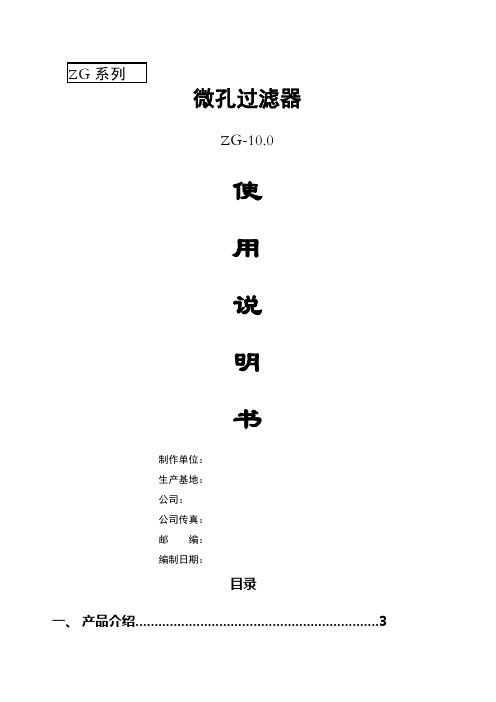
微孔过滤器ZG-10.0使用说明书制作单位:生产基地:公司:公司传真:邮 编:编制日期:目录一、 产品介绍 (3)二、产品特点 (3)三、滤芯的选择 (3)四、设备技术参数 (4)五、使用说明 (4)六、操作注意事项 (6)七、设备的维护与保养 (6)八、售后服务承诺 (7)九、合格证 (7)十、随机附件表 (8)一、产品介绍:本设备可用于食品、乳品、饮料、酒类、中药、化工行业的液体物料的气体的过滤..采用折叠式滤芯;折叠式滤芯是一种先进的固定型深层过滤芯;过滤公称精度范围可以从0.1μm直600.1μm..滤膜不受进料压力波动而影响过滤精度..其特有的低压差;高通量、良好的过滤精度能较低的经济费用成为取代线绕式、棉饼和纸板等非固定型过滤芯的新型滤芯而深受用户欢迎..二、产品特点:①化学相容性广、流通量大、压差低、使用寿命长..②过滤精度范围广、选择度大、可满足各种应用场合..③采用热熔工艺;牢固且无释放物污染产品..三、滤芯的选择:1、滤芯的用途很广泛;滤芯的品种、规格较多;选择型号是很重要的..根据用途可分为过滤液体和气体二种;规格大小可以分为5〃、10〃、20〃、30〃和40〃等..工作压力一般在0.1Mpa—0.4 Mpa..由于滤芯孔径不同;其流量也不尽相同;如0.2um—0.4 um过滤沌水的标准在300—500kg/h;如果要提高每小时的过滤量;则可以用多芯或20〃、30〃、40〃英寸组合;例如要过滤5t/h的无菌水;则可以选用0.2 um;30英寸7芯的过滤器..若过滤杂质多且有粘度;则应添加前置预过滤设备..气体的过滤与液体过滤稍有不同;它的过滤量以每分钟立方气体来计算..10英寸滤芯;孔径φ0.22 um;压力在0.12 Mpa;压差在0.01 Mpa时;流量为4-6m3/min;在发酵工业上广泛应用..2 、合适的滤芯;选用适当的孔径;若要除菌则选用0.2um-0.5um孔径的滤芯、药用针剂、抗菌素、血制品等用聚砜滤芯..如果要去除液体中的微粒;微生物和细菌大一些的离子、杂质;如白酒、黄酒、葡萄酒、口服液、可选用1-5um的孔径即可..过滤高温气体和发酵空气消毒气体要选用聚四氟乙烯滤芯..3 、不锈钢筒式过滤器;它内部装有不同孔径的滤芯..要达到精滤的目的;前期必须用预过滤设备生啤用硅藻土;纸板过滤机..药厂用板框、熔喷、绕线式;再用微孔除菌过滤芯;这样就能达到精滤的目的..4、一般用矿泉水、药用无菌水、电子工业集成电路用水、食品工业用高质量的水..筒式微孔过滤器设计时应成为一个独立的过滤系统;它可以带反冲洗;节省生产成本..5 、除了选择高质量的滤芯;还要选择高质量的过滤器;不锈钢加工是否精细;内外是否光洁;特别是插口处222、226、平口等三种形式是国际通用的;千万不能搞错;否则无法使用;或者由于加工粗糙;插上去起不到密封过滤的效果..注:在使用不锈钢外壳时要注意过滤液体对不锈钢是否有腐蚀作用;不适用的应选用其它材料的过滤器..四、设备技术参数:五、使用说明:1、安装底座:安装前看清进、出口方向..液体应从滤芯外部流向中心;与滤芯插口相通的管道是出口..在滤器管道上有箭头标示流向;切勿接错..2 、安装滤芯:222插口为插入式;226插口为卡入式..如果是多芯应将压板套在翅片上;将螺栓适度拧紧滤芯在高温下会受热伸长;若压板过紧;滤芯无伸长空间会产生扭曲变形影响过滤精度..3 、装好外罩并与底座用卡箍单芯或螺栓多芯连接密封好;注意密封垫要放置平整;检查密封处无渗漏..4 、滤器消毒:新过滤器使用前必须清洗干净..用于除菌的过滤器要杀毒消菌;消毒工作一般应在生产线进行;以免外界污染..现场蒸汽消毒应严格控制蒸汽压力与压差;避免因过高蒸汽压力和压差而损坏滤芯..5 、过滤液体时;应先打开过滤器顶部的排气阀;把筒内的气体排尽;让液体充满筒内;否则会影响流通量..6 、过滤介质流过滤器时会因受到阻力产生压力降即进入与流出时的压力差;为了克服这种阻力;保持足够的流量;必要时要有足够的工作压力..每种滤芯我们都给出了相应的温度、压力限定值;请用户按要求使用..为不使滤芯受到过大流量的冲击;开启阀门时一定要缓慢7 、自选泵配套使用时;请注意流量与压力要匹配..以选旋涡泵、输液泵等自吸泵为宜..8 、停机时应放光滤液;如果时间不长;可不必打开滤器;若时间较长;或滤液不宜长时间存放;则要清洗滤器或滤芯..六、操作主要事项:1 、过滤器使用前必须检查配件和密封圈是否安全;有无损坏;然后按要求把它装好..2、过滤器必须用清洁剂洗干净请不要用酸类清洗洗净后用高温蒸汽杀菌、消毒洗的过滤器进出口要包封好;避免污染..3 、安装时进出口不要接反;一般原则外进内出滤芯..4 、芯是生产厂家在洁净的生产厂房内用塑料袋封装的;未使用切勿撕破塑料包装..使用要求较高的滤芯;应先测气泡点检查滤芯完整性;安装好后要经过高温蒸汽杀菌消毒..5 、入口时;一定要垂直;插入时先用无菌水或经过过滤的滤液湿润一下密封圈;以减少插入时的摩擦阻力..222滤芯插入口后;再用压板扣住尖端翅片;拧紧螺丝不动即可..226接口的滤芯插入后;应选90度卡紧;如果有一点不小心;就会达不到密封;容易漏水而达不到您的使用要求..6、过滤的液体进入时;应打开过滤器上面的放气阀;让液体充满滤器内;否则将影响过滤效果..7、筒体的压力表是显示过滤气内液体的压力;如果是二级过滤;第一道过滤器压力表指数稍小一些是正常现象;随着使用时间的增长;他们的压差会增大;流速减少;这说明滤芯孔隙大多已被堵塞;就要清洗或更换滤芯..8 、在过滤时;使用的压力一般在0.1Mpa左右;能满足生产需要就可以了;随着时间与流量的增加;滤芯微孔被堵塞;压力将会增加;一般不要超过0.3Mpa;最告绝对不能超过0.5Mpa..否则滤器滤芯将会被击穿;发生意外事故;如果确定在0.5Mpa以上的可以与我们联系;我们将根据您的要求为您另外加工..9 、反冲洗滤芯;一定要用无菌水;否则会污染滤芯;反冲洗方法..原出口变进口;把无菌水反方向打进要注意关闭原液过滤管道;打开排污口;操作人员看到滤液明显好转为宜..10、滤芯不用时;应尽量把滤液放光;滤液不宜隔夜存放..停机时间不长时一般不要打开滤器;不要拔掉滤芯;停机时间长;在再次使用前一定要清洗滤芯和滤器也可以用反冲方法进行冲洗..11、我公司生产的滤芯耐温一般在25℃--50℃为宜.长期操作温度应控制在60℃以下;消毒温度121℃以下30分钟;如果操作温度较高;则可以用内衬不锈钢的增强聚四氟乙烯滤芯.12、如果要过滤化学溶剂和高浓度化学品可详见滤芯使用说明书;或者与我公司联系用特殊滤芯来解决..13、若是自选配套使用;则要注意需要的流量、压力及泵的扬程要匹配;一般选用旋涡泵;输液泵等为宜;材料为304或316L不锈钢;端面选用机械密封..七、设备的维护与保养:1、长期停用的过滤器;必须把滤器内外清洗干净;滤芯取下;洗净烘干;用塑料袋封口存放;以免损坏..清洗剂请勿用盐酸类腐蚀性物质;温度不宜过高防止聚丙烯发生变形..存放时避免污染与撞击..2、下来的滤芯若应浸泡在酸碱洗液里;浸泡时间不得超过24小时;酸碱液温度一般在20℃--25℃..建议酸或碱与水的比例是20%为好..最后用无离子水反复冲洗..蛋白质含量较商的滤液;滤芯最好用酶溶液浸泡清洗效果好;重新再使用时;使用前一定要先清洗干净;然后再用蒸气消毒..3、滤芯消毒时要注意掌握时间和温度;聚丙烯在高温消毒柜里以121℃为宜;用蒸汽消毒在0.1 Mpa蒸汽汽压力下;以130℃/20分钟为宜;聚砜和聚四氟乙烯用蒸汽消毒时可以达到142℃;压力0.28Mpa;时间在30分钟左右为宜;如果温度过高;时间过长;压力过大;则会损坏滤芯..八、售后服务承诺:1)及时向需方提供按合同规定的全部技术资料各图纸;有义务在必要时邀请需方参与供方的技术设计审查..2)按需方要求的时间到现场进行技术服务;指导需方按供方的技术资料各图纸要求进行安装、分部与整套试运及试生产..3)对于需方选购的与合同设备有关的配套设备;供方应主动提供满足设备接口要求的技术条件各资料..4)严格执行供需双方就有关问题如开会议的纪要或签订的协议..5)根据需方的要求为需方举办有关设备安装、调试、使用、维护技术的业务培训;保证需方运行、维修人员熟练掌握运行各维修技能..6)加强售前、售中、售后服务;把“24小时服务”;“超前服务”;“全过程服务”;“终身服务”贯彻在产品制造;安装、调试、大修的全过程..7)接到需方反映的质量问题信息后;在24小时之内做出答复或派出服务人员;尽快到达现场;做到用户不满意;服务不停止..8)随时满足需方对备品备件的要求..9)无论在何种情况下;供方决不以任何理由刁难需方..九、合格证十、随机附件表。
Y型过滤器技术参数
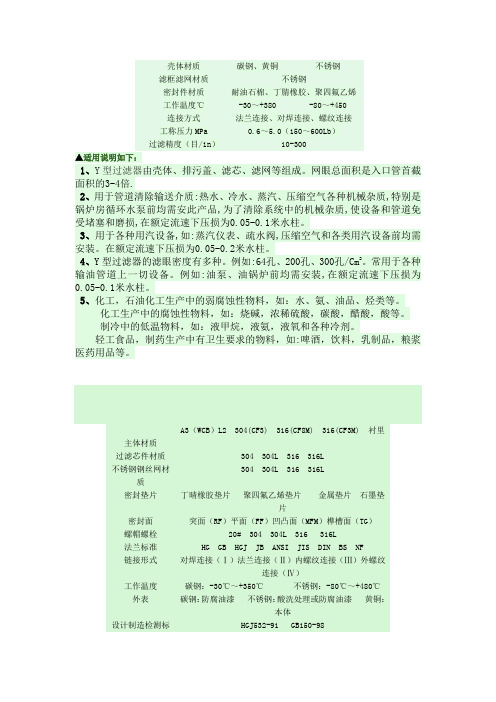
壳体材质碳钢、黄铜不锈钢滤框滤网材质不锈钢密封件材质耐油石棉、丁腈橡胶、聚四氟乙烯工作温度℃-30~+380-80~+450连接方式法兰连接、对焊连接、螺纹连接工称压力MPa0.6~5.0(150~600Lb)过滤精度(目/in)10-300▲适用说明如下:1、Y型过滤器由壳体、排污盖、滤芯、滤网等组成。
网眼总面积是入口管首截面积的3-4倍.2、用于管道清除输送介质:热水、冷水、蒸汽、压缩空气各种机械杂质,特别是锅炉房循环水泵前均需安此产品,为了清除系统中的机械杂质,使设备和管道免受堵塞和磨损,在额定流速下压损为0.05-0.1米水柱。
3、用于各种用汽设备,如:蒸汽仪表、疏水阀,压缩空气和各类用汽设备前均需安装。
在额定流速下压损为0.05-0.2米水柱。
4、Y型过滤器的滤眼密度有多种。
例如:64孔、200孔、300孔/Cm2。
常用于各种输油管道上一切设备。
例如:油泵、油锅炉前均需安装,在额定流速下压损为0.05-0.1米水柱。
5、化工,石油化工生产中的弱腐蚀性物料,如:水、氨、油品、烃类等。
化工生产中的腐蚀性物料,如:烧碱,浓稀硫酸,碳酸,醋酸,酸等。
制冷中的低温物料,如:液甲烷,液氨,液氧和各种冷剂。
轻工食品,制药生产中有卫生要求的物料,如:啤酒,饮料,乳制品,粮浆医药用品等。
A3(WCB)L2 304(CF3) 316(CF8M) 316(CF3M) 衬里主体材质过滤芯件材质304 304L 316 316L304 304L 316 316L不锈钢钢丝网材质密封垫片丁晴橡胶垫片聚四氟乙烯垫片金属垫片石墨垫片密封面突面(RF)平面(FF)凹凸面(MFM)榫槽面(TG)螺帽螺栓20# 304 304L 316 316L法兰标准HG GB HGJ JB ANSI JIS DIN BS NF链接形式对焊连接(Ⅰ)法兰连接(Ⅱ)内螺纹连接(Ⅲ)外螺纹连接(Ⅳ)工作温度碳钢:-30℃~+350℃ 不锈钢:-80℃~+480℃外表碳钢:防腐油漆不锈钢:酸洗处理或防腐油漆黄铜:本体设计制造检测标HGJ532-91 GB150-98准不锈钢钢丝技术特征(英制)SS Wire Gauze Parameter~目数∕in Mesh/in~孔数∕in2Hole/in2可截粒径ParticleDia(u)丝径Wire Dia(mm)有效过滤面积%EffectiveFiltrate Area1010020320.02000(0.510)64 204009550.01240(0.315)58 309006140.00921(0.224)54 4016004420.00760(0.206)48 5025003560.00598(0.152)46 6036003010.00480(0.122)44 8064002160.00402(0.102)421.00319(0.081)40▲Y型过滤器主要技术参数型号Model GLQ-SY环境温度AmbientTemperatureCS:–30℃~+350℃SS:-80℃~+480℃规格Size DN 15~600 GB81~59PN 0.6~5.0 FFRF螺帽螺栓Bolt/Nut20# 304 304L 316 316L壳体材质Body A3 304 304L PP316 316LH62 PTFE连接方式Joint Type法兰连接对焊连接螺纹连接Flange ButtWelding Threaded过滤精度Pore size 10~200(目/in)法兰标准FlangesHG GB SH HGJ JB ANSI JIS密封垫片Diaphragm(P/V)丁晴橡胶聚四氟乙烯金属垫片NBR PTFE MetalGasket设计检测标准ManufactureInspectionGB150-98 HGJ532-91滤芯材质Element 304 304L 316316L外表Coating CS:Paint SS:No Paint▲Y型过滤器安装尺寸参考:公称通径DN15DN20DN25DN32DN4DN5DN65DN8DN1DN125备注外型尺寸L12552350表格中的数字DN15至DN20为丝扣接口的尺寸,其他均为法兰接口尺寸H10212465公称通径DN15DN20DN25DN3DN35DN4DN45DN5DN6外型尺寸L386150 H53012。
过滤器参数详细说明
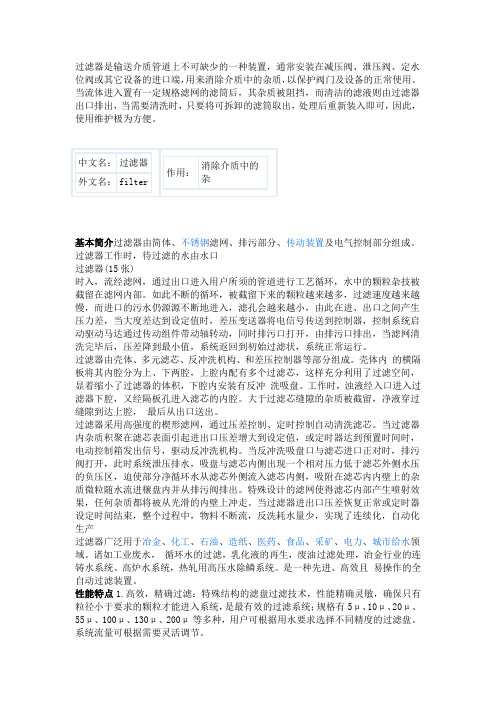
过滤器是输送介质管道上不可缺少的一种装置,通常安装在减压阀、泄压阀、定水位阀或其它设备的进口端,用来消除介质中的杂质,以保护阀门及设备的正常使用。
当流体进入置有一定规格滤网的滤筒后,其杂质被阻挡,而清洁的滤液则由过滤器出口排出,当需要清洗时,只要将可拆卸的滤筒取出,处理后重新装入即可,因此,使用维护极为方便。
基本简介过滤器由简体、不锈钢滤网、排污部分、传动装置及电气控制部分组成。
过滤器工作时,待过滤的水由水口过滤器(15张)时入,流经滤网,通过出口进入用户所须的管道进行工艺循环,水中的颗粒杂技被截留在滤网内部。
如此不断的循环,被截留下来的颗粒越来越多,过滤速度越来越慢,而进口的污水仍源源不断地进入,滤孔会越来越小,由此在进、出口之间产生压力差,当大度差达到设定值时,差压变送器将电信号传送到控制器,控制系统启动驱动马达通过传动组件带动轴转动,同时排污口打开,由排污口排出,当滤网清洗完毕后,压差降到最小值,系统返回到初始过滤状,系统正常运行。
过滤器由壳体、多元滤芯、反冲洗机构、和差压控制器等部分组成。
壳体内的横隔板将其内腔分为上、下两腔,上腔内配有多个过滤芯,这样充分利用了过滤空间,显着缩小了过滤器的体积,下腔内安装有反冲洗吸盘。
工作时,浊液经入口进入过滤器下腔,又经隔板孔进入滤芯的内腔。
大于过滤芯缝隙的杂质被截留,净液穿过缝隙到达上腔,最后从出口送出。
过滤器采用高强度的楔形滤网,通过压差控制、定时控制自动清洗滤芯。
当过滤器内杂质积聚在滤芯表面引起进出口压差增大到设定值,或定时器达到预置时间时,电动控制箱发出信号,驱动反冲洗机构。
当反冲洗吸盘口与滤芯进口正对时,排污阀打开,此时系统泄压排水,吸盘与滤芯内侧出现一个相对压力低于滤芯外侧水压的负压区,迫使部分净循环水从滤芯外侧流入滤芯内侧,吸附在滤芯内内壁上的杂质微粒随水流进穣盘内并从排污阀排出。
特殊设计的滤网使得滤芯内部产生喷射效果,任何杂质都将被从光滑的内壁上冲走。
黄铜 Y 型过滤器产品使用说明书

黄铜Y型过滤器产品使用说明书一、产品概述GLQ系列黄铜Y型过滤器(以下简称Y型过滤器)是输送介质的管道系统不可缺少的一种过滤装置,过滤器通常安装在减压阀、泄压阀、定水位阀或其它设备的进口端,用来清除介质中的杂质,以保护阀门及设备的正常使用。
二、结构特征和工作原理Y过滤器的结构为“Y”字型,支管内置过滤筒与滤网。
Y型过滤器在管道中的作用是滤除流体中的固体颗粒,以保护设备的正常工作。
当流体流入过滤器中,滤网会阻止比滤网孔径大的固体颗粒通过,从而保证通过过滤器的流体不含大尺寸的固体颗粒。
清洗滤网时,将过滤器阀盖旋开,取出滤网,清洗滤网后重新装入并旋紧阀盖即可。
维护过程比较简单。
三、产品命名规则四、外型尺寸及零件材质执行标准GB/T8464-2008《铁制和铜制螺纹连接阀门》公称通径DN15-DN50公称压力PN16适用介质水及60%以内的乙二醇水溶液介质温度0~120℃(液态)滤网目数16目(其它目数需要定制)主要零件材质阀体:黄铜;阀盖:黄铜;过滤网:不锈钢;密封垫片:PTFE五、保管、安装及使用说明1.安装前应清洗管道、清除管道内污垢和泥砂等异物,避免安装后过滤网被异物堵住。
2.过滤器的进水和回水管道最好安装压力表,如果进水回的压力表计数相差甚大,可能过滤网上已经有不少杂质,当有液体流经过滤器时,液体阻力比正常使用要大得多,此时需要即时清洗过滤网。
3.该阀通常安装于水平管路,但也可安装于垂直管路上或倾斜管路上,并注意介质流向与阀体上箭头方向相一致。
4.安装过滤器时要注意预留一定的维修空间,以便正常的日常维护。
5.使用工况要符合性能规范要求。
6.该阀应放在干燥的仓库内严禁露天存放,长期存放,应定期保养。
六、可能发生的故障及消除方法公称通径 L (mm ) H (mm ) GDN15 56.5 40 1/2” DN20 69 45 3/4” DN25 77 50 1” DN32 96.5 66 1 1/4” DN40 105 75 1 1/2” DN50 127 89 2”可能发生的故障 发生故障的原因 消除办法流量较小或者 水流阻力变大长期使用,过滤网被 杂质堵住清洗过滤网密封面渗漏1、端盖未拧紧。
陶瓷膜过滤器设备说明书WTM-CM-01

陶瓷膜过滤器设备说明书WTMCM01一、产品概述WTMCM01陶瓷膜过滤器是一款高效、可靠的过滤设备,采用先进陶瓷膜技术,具有耐高温、耐腐蚀、抗污染等特点。
本产品适用于各种工业废水、生活污水、饮用水等水处理领域,能够有效去除水中的悬浮物、胶体、微生物等杂质,实现水质净化。
二、产品特点1. 高效过滤:采用独特的陶瓷膜材料,孔径均匀,过滤精度高,截污能力强。
2. 耐高温:可在高达150℃的环境下稳定运行,适应各种高温工况。
4. 抗污染:陶瓷膜表面光滑,不易粘附污染物,清洗方便,运行周期长。
5. 低碳环保:设备运行过程中无需添加化学药剂,无二次污染,符合环保要求。
6. 智能化控制:配置先进的PLC控制系统,实现设备自动化运行,降低人工成本。
三、技术参数1. 设备型号:WTMCM012. 膜材料:氧化锆、氧化铝、氧化钛等3. 膜孔径:0.1μm、0.2μm、0.4μm、0.8μm、1.0μm4. 设计流量:1m³/h、2m³/h、3m³/h、5m³/h、10m³/h5. 工作温度:20℃~150℃6. 耐压范围:0.1MPa~1.0MPa7. 电源要求:AC 220V/50Hz(可根据客户需求定制)四、安装与调试1. 设备安装前,请确保现场环境整洁,预留足够的空间和通道。
2. 按照设备布局图进行安装,确保各部件安装到位,连接紧密。
3. 连接电源、进水管道、排水管道及控制系统,确保线路无误。
4. 检查设备各部件是否正常,启动设备进行调试。
5. 调试过程中,观察设备运行情况,如有异常,请及时排查原因。
6. 调试合格后,设备方可投入正常运行。
五、操作与维护1. 设备启动前,请确保进水水质符合要求,避免对膜元件造成损害。
2. 设备运行过程中,定期检查进水压力、产水流量等参数,确保设备正常运行。
3. 定期清洗膜元件,防止污染物积累,影响过滤效果。
4. 每隔一定时间,对设备进行反冲洗,恢复膜元件通量。
高效空气过滤器使用说明书

高效空气过滤器使用说明书尊敬的用户:感谢您购买我们的高效空气过滤器。
本说明书将为您提供详细的使用指南和维护建议,以确保您能充分利用该产品的功能,同时保证您的舒适与健康。
1. 产品概述高效空气过滤器是一种先进的空气净化设备,旨在过滤室内空气中的有害物质,如细菌、病毒、花粉和灰尘等。
通过该过滤器,您可以呼吸到更加清新和洁净的空气,提高室内空气质量,预防呼吸道疾病。
2. 产品安装在安装前,请确保已阅读产品安全手册,并按照相关要求进行操作。
以下是产品安装的简要步骤:a) 选择合适的安装位置:确保过滤器能够正常地引入和排放空气,同时避免与其他电器设备产生干扰。
b) 固定设备:使用附带的安装配件,将过滤器牢固地安装在所选位置上,确保其稳定性。
c) 连接电源:将过滤器的电源线连接到合适的供电插座上,并确保插座与供电电压匹配。
3. 使用说明a) 开启/关闭电源:根据需要,将电源开关置于“开启”或“关闭”位置。
当不使用过滤器时,建议将电源关闭,以节约能源。
b) 调节风速:通过控制面板上的风速调节器,可根据实际需要选择不同的风速档位。
一般情况下,建议选取适中的风速以保证良好的过滤效果。
c) 过滤器更换提醒:根据产品规格和使用情况,过滤器可能需要定期更换。
当面板上的指示灯亮起或显示屏上显示相关提示时,表示过滤器需要更换。
请务必按照说明书中的步骤更换过滤器,并使用原装配件。
4. 产品维护a) 定期清洁:为了保持过滤器的最佳工作状态,建议定期清洁其表面和过滤网。
使用干净的湿布轻轻擦拭过滤器表面,并确保彻底晾干后再次使用。
b) 定期维护:定期检查过滤器的运行状况和所有连接口是否紧固。
如发现异样或故障,请立即与售后服务中心联系,并请勿私自拆解或修复。
c) 季节性使用:如果过滤器长时间不使用,建议在使用前进行检查和清洁,并妥善存放在干燥和通风的地方,以防止积尘和损坏。
5. 注意事项a) 使用环境:本产品适用于室内空气净化,在户外或含有腐蚀性气体的环境中使用会降低产品性能,甚至损坏产品。
过滤器使用说明书
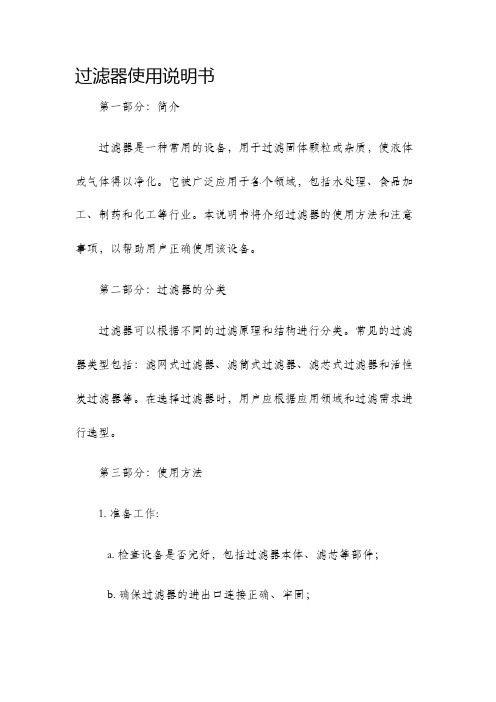
过滤器使用说明书第一部分:简介过滤器是一种常用的设备,用于过滤固体颗粒或杂质,使液体或气体得以净化。
它被广泛应用于各个领域,包括水处理、食品加工、制药和化工等行业。
本说明书将介绍过滤器的使用方法和注意事项,以帮助用户正确使用该设备。
第二部分:过滤器的分类过滤器可以根据不同的过滤原理和结构进行分类。
常见的过滤器类型包括:滤网式过滤器、滤筒式过滤器、滤芯式过滤器和活性炭过滤器等。
在选择过滤器时,用户应根据应用领域和过滤需求进行选型。
第三部分:使用方法1. 准备工作:a. 检查设备是否完好,包括过滤器本体、滤芯等部件;b. 确保过滤器的进出口连接正确、牢固;c. 根据过滤要求选择合适的滤芯或滤网。
2. 安装过滤器:a. 将过滤器安装在合适的位置,确保不会受到冲击或振动;b. 确保设备的进出口与管道连接紧密,无泄漏;c. 根据具体型号,在进出口管道处安装适当的阀门和流量计。
3. 过滤器的操作:a. 打开进出口阀门,使液体或气体通过过滤器;b. 根据需要调节流量大小,注意在规定的压力范围内操作;c. 定期观察过滤器的运行状态,如发现问题及时维修或更换滤芯;d. 当维修或更换滤芯时,先关闭进出口管道的阀门,避免液体或气体外溢。
4. 清洗和维护:a. 根据使用情况,定期清洗过滤器,防止堵塞和损坏;b. 使用适当的清洁剂或水进行清洗,避免使用腐蚀性物质;c. 清洗后彻底冲洗并晾干过滤器,确保无水渍残留。
第四部分:注意事项1. 使用过滤器前,请确保详细阅读该设备的操作手册,并按照要求使用;2. 定期检查过滤器的工作状态,如发现异常请及时处理,避免影响正常使用;3. 避免将过滤器暴露在严重的振动或冲击环境中,以免影响其过滤效果;4. 根据过滤器的使用寿命,定期更换滤芯或滤网,避免过滤效果下降;5. 避免将过滤器置于高温或低温环境中,以免损坏设备;6. 使用过滤器时,需注意操作的安全,避免发生意外事故。
第五部分:常见故障及解决方法1. 过滤效果降低:a. 检查滤芯是否需要更换,如需要更换请按照要求进行;b. 检查过滤器是否被杂质堵塞,如有堵塞请进行清洗。
高效纤维束过滤器安装及操作程序使用说明书
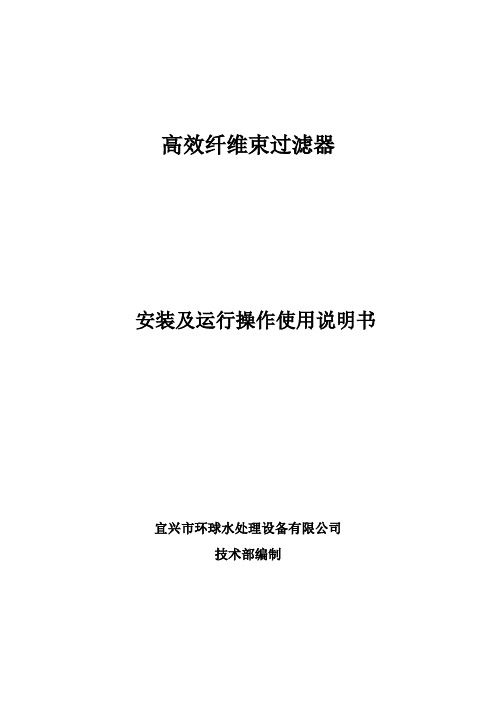
高效纤维束过滤器安装及运行操作使用说明书宜兴市环球水处理设备有限公司技术部编制一、高效纤维束过滤器安装说明GZT-2800高效纤维过滤器安装规范说明1、设备简介:纤维过滤器为钢制圆柱形罐体,采用压力式过滤。
利用纤维做滤料,利用流体力学原理,自动调节纤维料的密度,从而使被处理水出水浊度达到使用要求。
2、安装注意事项:、设备到安装现场后按发货清单先核对清点数量和附件,确认在运输过程中无缺少和损坏。
、在安装室外过滤器时先确认设备基础是否平整,应符合设计要求后方可以进行安装。
、按巴格德雷合同区域B区供水工程的(图号:T004-1207-02-01及T004-1107-02-02)的工艺安装配置图的尺寸和方位将室外过滤器的安装撬固定好。
2个过滤器合用一个撬。
、过滤器应安装垂直,外壳垂直度误差应小于3mm.壳体找正后应将支腿与设备撬垫铁焊牢固定。
、过滤器管线室内安装时先把管撬按图纸尺寸固定,过滤器的配水系统、排水系统的支管与母管按工艺配置图进行安装,各管线中心线应垂直,支管的水平偏差不得大于±2mm。
过滤器的配水系统、排水系统的支管与母管的所有连接采用法兰连接,安装时按照法兰边上的钢制印,按照数字顺序从上到下排列安装。
、管线中的阀门按流程图及配置图的位置和尺寸进行安装,阀门安装方位应一致,便于操作。
、待过滤器及过滤器的管线安装好后,将控制箱按设计要求的方位安装固定好,然后按我公司在控制箱上的连接标示和管线上的阀门用不锈钢气路管线进行连接。
同时将气源处理装置、空压机、电磁换向阀等按要求安装固定好。
二、高效纤维束过滤器操作规程及说明一、准备工作:1、设备运行前应检查各阀门及配套设备是否能正常工作。
2、检查泵、风机等电器元件的接线是否正确、匹配。
二、打开排气阀和进水阀,调整流速到30-40m/h,压力至,待水充满滤床至上排气口有水出来。
二、然后关闭排气阀,同时开启出水阀,进行正常工作。
三、空气清洗:在运行一段时期后,滤床如失效,必须清洗污物。
高效粒子过滤器(HEPA)筛选器技术说明说明书
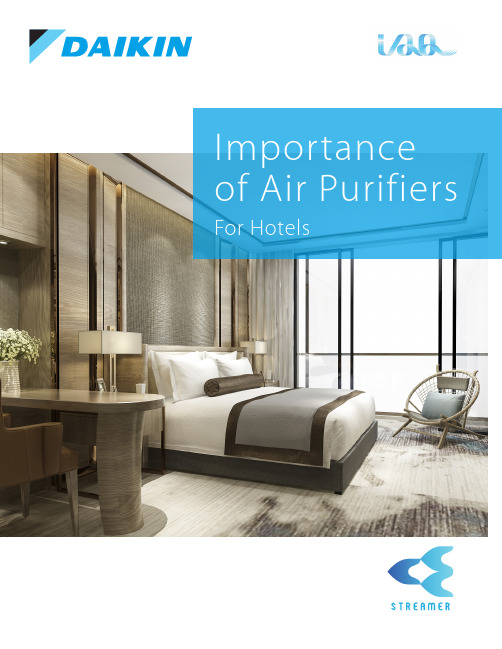
of Air Purifiers For Hotels“Research shows that the particle size of SARS-CoV-2 is around 0.1 micrometer (µm). However, the virus generally does not travel through the air by itself. These viral particles are human-generated, so the virus is trapped in respiratory droplets and droplet nuclei (dried respiratory droplets) that are larger than an individual virus. Most of the respiratory droplets and particles exhaled during talking, singing, breathing, and coughing are less than 5 µm in size. By definition, a High Efficiency Particulate Air (HEPA) filter is at least 99.97% efficient at capturing particles 0.3 µm in size. This 0.3 µm particle approximates the most penetrating particle size (MPPS) through the filter. HEPA filters are even more efficient at capturing particles larger and smaller than the MPPS. Thus, HEPA filters are no less than 99.97% efficient at capturing human-generated viral particles associated with SARS-CoV-2”.According to the 2020 World Air Quality Report, countries in the Middle East and Africa suffer from high exposure toPM2.5, with Oman, Qatar, Bahrain, UAE, Egypt and Saudi Arabia ranking among the highest.Several studies have found a significant relationship between air pollution and the severity of COVID-19 infection.Global map of estimated PM 2.5 exposure by country / region in 2020(1) Ventilation in Building, CDC (Centers for Disease Control and Prevention) Ventilation in Buildings | CDCAccording to the World Health Organization (WHO) air pollution from both outdoor and indoor sources represents the single largest environmental risk to health globally, and causes 7 million deaths a year worldwide.What is a HEPA filter and why use aportable HEPA air cleaner?2020 World Air Quality IndexAltered guest experience The pandemic has boosted the awareness about the importance of indoor environments and has triggered changes in our travel decisions. Air quality has become a major area of concern for travelers and there has been an increased demand for the hotel industry to provide options for rooms with better filtration and purification.Less occupancyIncreased risk of spread of communicative disease (e.g. COVID19)Lower staff productivityHow air pollutants affect guests and staff in a hotelWhy do you need air purifiers in your hotel?Clean air is essential for the guests’ wellbeing and health, as it positively impacts their breathing and the quality of their sleep. Guests feel more energized and sleep better, which contributes to better relaxation and overall experience. Air pollutants could cause discomfort such as nausea, drowsiness and fatigue and even exacerbate respiratory issues.Improved guest experienceby implementing air purification systems. An increasing number of hotel guests are concerned about the detrimental impact of air on their health. Investing in air purification systems can reassure guests and eventually lead to more bookings.Gain a competitve edgeby reducing the risk of airborne virus transmission in your hotel environment. COVID-19 particles can live in the air for up to three hours. Airborne infection is 15-20 times more likely to occur indoors than outdoors.Emphasize your commitment to the health and safety of your guestsby communicating the benefits of clean air. Guests want to be reassured that the air they breathe is clean and healthy and does not represent a risk for their health.Increase your hotel reputationby investing in air purification system that positively impact their concentration and productivity.Improve your staff productivityAs a global leader in the HVAC-R industry, we rely on more than 90 years of experience and expertise to deliver the highest quality solutions and services. Because our care for the planet is absolute, our air purifiers are designed with the latest technology to consume less energy and reduce their environmental impact. Our commitment to quality also means providing the best service experience for ourcustomers. From on-site support and installations to troubleshooting and maintenance, our experts are here to help you achieve the perfect climate.The Daikin DifferenceMinimizes asthma and allergy symptoms by removing airborne allergens such as mold,mites, and pollen as well as adjuvant substances, viruses, and bacteria.Clean and healthy airThe causes of bad odors are decomposed and removed by Streamer and filter technologies.DeodorizationOur unique air intake design enables a greater volume of air to be cleaned for faster air purification.Powerful suctionVarious functions such as a monitor displaying current air conditions make operation simple and easy.ConvenienceWhy choose Daikin’s air purifier solutions?Institut Pasteur de Lille evaluated the effectiveness of Daikin’s air purifiers against respiratory viruses.According to tests performed in the laboratories of the Institut Pasteur de Lille, Daikin’s air purifiers eliminate more than 99.98% the human coronavirus HCoV-229E in 2.5 minutes*. This virus is of the same family as SARS-CoV-2, the coronavirus behind the COVID-19 pandemic. The units have also been evaluated as 99.93% effective against the H1N1 virus in 2.5 minutes*. H1N1 is the virus causing common flu.This means Daikin’s air purifiers are an additional measure in the fight against respiratory diseases. The effectiveness of our compact plug-and-play purifier is achieved through a combination of the high performance electrostatic HEPA filter, which traps the virus, followed by an intense exposure to Daikin’s patented Flash Streamer technology, which eliminates the virus, can strongly contribute to reducing the risk of respiratory virus transmission.Takes in air over a wide area from 3 directions.Powerful suctionEfficiently catches dust and pollutants with an electrostatic HEPA filter.Effective capturing of pollutantsUses Daikin’s streamertechnology to decompose, by oxidation, harmful substances caught on the filterDecompositionMC55 SeriesMC55 SeriesDaikin’s air filtration unit is equipped with 3-stage filtration including 99.99% efficient HEPA filter. It is a portable, with nominal 1000 CFM, air filtration unit designed to serve small to medium-sized facilities like health care facilities to quickly and inexpensively convert standard patient rooms to negative pressure isolation rooms. It also helps any conditioned space as a recirculating device that provides equivalent outdoor air changes (ACH) to eliminate air borne infections.The Air Filtration unit can be operated in any of the below modes: 1. 100 % Exhaust2. 100% RecirculatingThis powerful unit is equipped with an EC Fan with variable speed control and can deliver airflow from 300 CFM to 1000 CFM. The EC Fan ensures lower sound levels and high efficiency.DAFU 1000HEPA FilterHigh Efficiency MERV 8 FilterRecommended ProductsPlug shape UK type (three pin) for MC55VB & EU type (two pin) for MC55WCasing Colour WhiteFanType Multi Blade Fan (Sirocco fan)Air flow rate Airpurifying operationQuiet/Low/Standard/Turbo m³/h66 / 120 / 192 / 330Sound pressure level Air purifying operation Quiet/Low/Standard/Turbo dBA 19 / 29 / 39 / 53Air purifying operation Power inputQuiet/Low/Standard/TurbokW0.008 / 0.010 / 0.015 / 0.037Deodorizing method Flash streamer + Deodorizing catalystDust collecting method Electrostatic HEPA filterAir filter Type Polyethylene terephthalate netSign ItemDust Sign: 3 stages / Odour: 3 stages / Anti-pollen mode / Child proof lock lamp / PM2.5 sensor lamp: 6 stages / Airflow rate: Quiet/Low/Standard/Turbo / AUTO FAN mode / Econo mode / ON/OFF lamp / Streamer lampPower supply Phase/Frequency/VoltageHz/VSingle Phase 50Hz 220-240 / 60Hz 220-230TypeAir PurifierOptional Accessories Replacement filterDust CollectionKAFP080B4 (1 sheet)(Purchase of new filters is needed after about 10 years)Deodorising -Humidifying-The applicable room area is appropriate for operating the unit of maximum fan speed. Applicable room area indicates the space where a certain amount of dust particles can beremover in 30 minutes. (JEM 1467) | Operating sound levels are the average of values measured at 1m away from the front, left, right and top of the unit. (These are equal to the values in an anechoic chamber) | Electrostatic HEPA filter is attached in the unit. | Other function: Active plasmation function. Auto-restart function.About the dust collection and deodorizing capacity of an air purifier:• Not all harmful substances in cigarette smoke (carbon monoxide, etc.) can be removed.• Not all odour components that emanate continuously (from building materials and pets, etc.) can be removed.The Daikin air purifier is not a medical device and is not meant to be used as a substitute to any medical or pharmaceutical treatment.› Pure air thanks to air purification technologies › Catches fine particles of dust› Powerful suction and whisper quiet › New stylish and compact designMC55 Series1) Coverage area according to JEM1467 [2013]2) Coverage area according to NRCC-54013 [2011]DAFU 1000Quick Selection GuideNotes:1. Based on nominal airflow 1000 CFM2. Room height considered 3 metersRecommended Air Change Rate based on applicationNotes:Sound Power levels measured in accordance to BS EN ISO 3747:2010Sound pressure calculated (parallelepiped measurement surface) at a distance of 1.5mStep 1: Select the air change rate based on application.Step 2: Select the number of units required based on air change rate and cleanable room area.DAFU 1000*Lobby area, conference rooms, restaurants, gym/fitness areaThe present publication is drawn up by way of information only and does not constitute an offer binding upon Daikin MEA. Daikin MEA has compiled the content of this publicationto the best of its knowledge. No express or implied warranty is given for the completeness, accuracy, reliability or fitness for particular purpose of its content and the products and services presented therein. Specifications are subject to change without prior notice. Daikin MEA explicitly rejects any liability for any direct or indirect damage, in the broadest sense, arising from or related to the use and/or interpretation of this publication. All content is copyrighted by Daikin MEA.P.O. Box 18674, Plot MO0426, JAFZA North, Jebel Ali Free Zone, Dubai, UAE | Tel: +971 (0) 4 815 9300 | Fax: +971 (0) 4 815 9311E-mail:*********************:TollFree:800-DAIKIN(324546)DMEA21-220。
高速过滤器技术说明

高速过滤器技术说明一、主要技术参数·直径:D=1.5m·流量:Q=40.2-80.4m3/h·最高滤速:V=20-40m/h·最大滤水量:Q=125-200m3/h·最大进水压力:0.4MPa·平均压力损失:0.04~0.06Mpa·进水悬浮物:≤80mg/L·出水悬浮物:≤5-15mg/L·进水PH值:6.5-8.9·反洗水强度:15m3/m2.h·反洗水压力:0.15Mpa·反洗空气压力:0.07MPa二、主要结构及工作原理高速过滤器主要由主体、封头、托架、进出水系统、反洗出水装置等部件组成。
1、主要结构(1) 主体壳体上下封头采用日本合资企业宜兴北海封头有限公司的椭圆形标准封头,壳体采用武钢钢板,坡口机打好坡口后,用卷板机卷制成形,所有焊缝均用埋弧自动焊机焊接,其焊接质量符合GB150-1998钢制压力容器标准。
(2) 滤料承托用无缝钢管组成管栅,下面用工字钢作托架。
(3) 进出水系统及反冲洗布气进水系统的管件均采用无缝钢管,其管件均按S311钢制管道零件标准要求制造,所有法兰按JB81-940.6MPa凸面板式平焊钢制管法兰标准制造。
(4) 反洗出水装置(进水分配槽)采用折板淹没式结构,可有效防止滤料的跑失。
(5) 过滤器整体制作完毕,每台进行压力试验,其试验方法和要求按GB150-1998钢制压力容器标准和JB2932-86水处理设备制造技术条件标准进行。
2、工作原理原水流入主体内经滤料层分别除去原水中的油渣悬浮物等水中杂物,滤后水流出主体。
三、主要部件材质·主体:Q235A碳钢·托架:Q235A碳钢·进水系统:Q235A碳钢·反洗出水装置:Q235A碳钢·紧固件:Q235A碳钢四、电器控制系统(无)五、设备设计、制造、检验所遵循的标准目录该产品在设计、制造、检验、包装运输及安装过程中所遵循的标准均为国标(GB)或部标(JB)这些通用标准目录省略,只提供专用标准目录如下:GB150-1998 钢制压力容器标准JB2932-86 水处理设备制造技术条件JB/ZQ4000.2-86 切削加工件通用技术条件JB/ZQ4000.3-86 焊接件通用技术条件JB/ZQ4000.5-86 铸件通用技术条件JB/ZQ4000.7-86 锻件通用技术条件JB/T5000.5-98 有色金属铸件通用技术条件JB/ZQ4000.9-86 装配技术条件JB/ZQ4000.10-86 涂装通用技术条件JB/ZQ4286-86 包装技术通用技术条件GB1176 铸造铜合金技术条件GB1220 不锈钢棒GB6414 铸件尺寸公差GB9439 灰铸铁件GB3797-89 装有电子器件电控箱技术条件GB/4720-84 低压电器电控箱GB/T4942.2-93 低压电器外壳防护等级GB8923-85 涂装前钢材表面锈蚀等级和除锈等级GB4879-99 防锈包装YJ010 抛丸喷砂技术条件及检验方法JB/ZQ4000.1-86 产品检验通用技术要求适用于本产品的“产品出厂前的检验规则和方法”适用于本产品的“产品安装手册”及“产品安装检验规则和方法”适用于本产品的“产品型式试验规则”“产品的试验方法”六、设备的可靠性及耐久性1、设备无故障运行时间在5年以上。
GSL-4高速过滤器技术说明

GSL-4高速过滤器技术说明一、主要技术参数·规格:φ4000mm·滤水面积:12.56 m2·滤速:40m/h·最大滤水量:500m3/h·最大进水压力:0.4MPa·反洗水强度:40m3/m2.h·反洗水压力:0.15Mpa·反洗空气强度:15m3/m2.h·反洗空气压力:0.07Mpa·滤前水质:悬浮物:≤80mg/L油≤10-20mg/L·滤后水质:悬浮物:≤10mg/L油≤5-10mg/L二、主要结构及工作原理高速过滤器主要由筒体、封头、过滤系统、进出水系统、反冲洗系统等部件组成。
1、主要结构(1) 主体上下封头采用中日合资企业宜兴北海封头有限公司的正半椭圆形标准封头,筒体采用武钢钢板,坡口机打好坡口后,用卷板机卷制成形,筒体上的所有纵横焊缝均用埋弧自动焊机焊接,其焊接质量符合GB150-1998钢制压力容器标准。
(2) 滤层出水装置采用厚质钢板装配专用滤帽组成,出水时均匀统一,并在下部设有工字钢作托架。
(3) 进出水系统及反冲洗布气进水系统的管件均采用无缝钢管,其管件均按S311钢制管道零件标准要求制造,所有法兰按JB81-94凸面板式平焊钢制管法兰标准制造。
(4) 反洗出水装置(进水分配槽)采用折板淹没式结构,可有效防止反冲洗时滤料的跑失。
(5) 过滤器整体制作完毕,每台进行压力试验,其试验方法和要求按GB150-1998钢制压力容器标准和JB2932-86水处理设备制造技术条件标准进行。
2、工作原理原水流入罐体内,由上而下经过滤料将原水中的油、悬浮物等予以截留,滤后水流出罐体。
当进出水压力差增大、滤速减漫、出水量降低时,反洗装置工作、反冲掉吸附于滤料上的杂物,保证过滤器的正常运行。
三、主要部件材质·主体:Q235碳钢·滤板:Q235碳钢·托架:Q235碳钢·滤头:ABS·滤料:无烟煤、石英砂、鹅卵石(用户自备)·进出水管:无缝钢管·反洗水、气管:无缝钢管·紧固件:Q235A碳钢四、设备设计、制造、检验所遵循的标准目录该产品在设计、制造、检验、包装运输及安装过程中所遵循的标准均为国标(GB)或部标(JB)这些通用标准目录省略,只提供专用标准目录如下:GB150-1998 钢制压力容器标准JB2932-86 水处理设备制造技术条件JB/ZQ4000.2-86 切削加工件通用技术条件JB/ZQ4000.3-86 焊接件通用技术条件JB/ZQ4000.7-86 锻件通用技术条件JB/ZQ4000.9-86 装配技术条件JB/ZQ4000.10-86 涂装通用技术条件JB/ZQ4286-86 包装技术通用技术条件GB8923-85 涂装前钢材表面锈蚀等级和除锈等级GB4979-85 防锈包装YJ010 抛丸喷砂技术条件及检验方法JB/ZQ4000.1-86 产品检验通用技术要求适用于本产品的“产品出厂前的检验规则和方法”适用于本产品的“产品安装手册”及“产品安装检验规则和方法”适用于本产品的“产品型式试验规则”“产品的试验方法”五、设备的可靠性及耐久性1、设备无故障运行时间在5年以上。
EHEIM professionel II ap 系列外部过滤器和温度过滤器的使用说明和技术信息说明

Istruzioni per l’usoe informazioni tecnicheFiltro esterno per acquari 2026 e 2028Termofiltro 2126 e 2128Modello:vedi targhetta sulla parte superiore del filtroVi ringraziamoper l’acquisto del Vostro nuovo filtro esterno per acquari della serie EHEIM professionel II ap-partenente alla generazione high tech. Il sistema innovativo, grazie al sistema ausiliario di as-pirazione integrato, l’adattatore del tubo flessibile conformato per il funzionamento e il controllo visivo di portata, coniuga un comfort ottimale alla massima sicurezza. La grande capacità del contenitore, insieme alla struttura del materiale filtrante perfettamente adattata, garantiscono un sicuro smaltimento delle sostanze nocive.Tutte le informazioni indispensabili sulla prima installazione, la cura e la manutenzione si potranno leggere nelle istruzioni complete.Per quanto riguarda i modelli con termofiltro leggere le avvertenze appositamente contrassegnate.Il prodotto è stato approvato secondo le relative norme e disposizioni nazionali ed è conforme alle norme UE.Descrizione generale del funzionamentoIl filtro esterno EHEIM professionel II depura l’acqua in un sistema a circuito chiuso. La circola-zione ininterrotta dell’acqua viene garantita dalla pompa integrata, che non necessita di ma-nutenzione. L’acqua attraversa i vari strati filtranti mentre viene trattata con sistemi meccanici, biologici o assorbenti per tornare in fine nell’acquario. Per il funzionamento del filtro è necessario eliminare all’accensione l’aria dal sistema, operazione facilmente realizzabile grazie al sistema ausiliario di aspirazione integrato.Avvertenza:un filtraggio ottimale si ottiene impiegando materiale filtrante originale EHEIM (v. capitolo …riempimento di materiale filtrante“).Con riserva di modifiche tecniche.Filtro esterno 2026 e 2028per acqua dolce e marinaTermofiltro 2126 e 2128solo per acqua dolce (versione resistente all’acqua salata su richiesta)ቢMorsetto stringitubi ባblocco di raccordo con rubinetti integrati ቤleva blocco rubinetti ብindicatore ቦleva di blocco ቧpompa con sistema ausiliario di aspirazione integrato ቨparte superiore filtro ቩguarnizione di tenuta ቪgomito ቫgriglia di copertura ቭstrato filtrante bianco ቮstrato filtrante blu ቯboccole di gomma ተcestelli del materiale filtrante ቱclip di chiusura ቲcontenitore filtro ታtubo di aspirazione ቴcestello filtro ትtronchettodi uscita ቶdiffusore con tappo ermetico k21ventose con clip k 22tubi flessibili k 23galleggian-te con supporto e molla k24vaselina.Termofiltro:k25Pannello di comando k 26termosensore k 27nastro adesivo.Dopo aver aperto la confezione accertarsi che contenga tutti i pezzi.Indicepagina Definizioni83Inserire l’adattatore84Installazione del tubo flessibile84Riempimento di materiale filtrante85Messa in servizio86Cura e manutenzione87Cosa fare se...89Tabella dei ricambi 180Inserire l’adattatoreEstrarre il filtro e gli accessori dalla scatola e montarli come indicato:La barra di bloccaggio dell’adattatore deve essere alzata nel senso dei collegamenti del tubo flessibile per chiudere i rubinetti.Premere il pulsante rosso di sicurezza sulla parte superiore della testa della pompa ed allo stesso tempo estrarre la leva dell’adattatore per quanto possibile.Inserire l’adattatore nei relativi zoccoli sulla testa della pompa ed allora respingere nella leva dell’adattatore per quanto possibile. Ciò metterà l’adattatore nella guarnizione ed automatica-mente aprirà i collegamenti del tubo flessibile.Installazione del tubo flessibile(1/2)Collegare il tubo di aspirazione e il cestello filtro e montarli nell’acquario servendosi dell’ap-posito supporto.(3)Collegare il tronchetto di scarico e il diffusore tramite un tubetto e fissarli alla parete interna della vasca con le ventose (usare il tappo ermetico per la parte aperta del tubo del diffusore solo quando il filtro è in funzione.Suggerimento:(3)Il diffusore si può installare al di sotto o in corrispondenza del livello dell’ac-qua, a seconda dell’intensità desiderata per il movimento in superficie.Tagliare i tubi flessibili nella lunghezza necessaria e spingerli per almeno un cm. sul tubo di aspi-razione e il raccordo di scarico. Accertarsi che i tubi siano tesi e che non abbiano pieghe.Suggerimento:ammorbidire i tubi flessibili nell’acqua calda in modo da raddrizzare eventuali pieghe.(4)Collegare il tubo flessibile del tubo di aspirazione con il raccordo del blocco (contrassegno ̃)e il tronchetto di scarico con il raccordo di mandata (contrassegno ̅) sul blocco di raccordo.Spingere le due estremità dei tubi flessibili fino all’arresto (eventualmente renderli più morbidi prima con acqua calda).(5/6)Infine sistemare il morsetto stringitubi, in due pezzi, intorno ai terminali montati, unirlo lateral-mente e chiuderlo premendo simultaneamente sui due elementi.Avvertenza:usare sempre tubi flessibili originali EHEIM.Controllare periodicamente il corretto fissaggio dei tubi flessibili.Installazione del filtro(7)Durante la sistemazione del filtro così preparato nell’armadietto, controllare l’altezza raccoman-data per il montaggio: tra la superficie dell’acqua e la base del filtro non devono esserci più di 180cm. per garantire un funzionamento perfetto del filtro.Attenzione:Usare il filtro solo in posizione verticale.a kk b kcEstrazione del blocco di raccordo rubinetti(11)Tirare in avanti la leva del blocco di raccordo fino all’arresto premendo contemporaneamente a destra la leva rossa di blocco. I raccordi dei tubi sono ora chiusi e il blocco di raccordo salteràfuori dal suo alloggiamento.Apertura del filtro(12/13)Aprire le clip di chiusura del contenitore filtro, spingerle verso l’alto e sollevare il conteni-tore.(14)Rimuovere la griglia di copertura, l’ovatta sintetica ed estrarre i singoli cestelli per i materiali filtranti l’uno dopo l’altro.Per facilitare l’operazione, af-ferrare e sollevare le maniglie retrattili.RiempimentoRiempire il primo cestello di EHEIM MECH avendo premura di lasciare lo spazio necessario per collocare il cuscino azzurro sotto l’impugnatura estraibile.(15)Riempire il secondo (e terzo) cestello con la massa biologica SUBSTRAT pro fino al bordo.Attenzione:non riempire esageratamente per non intasare le guide del tubo di raccordo.(16)Sciacquare a fondo sotto il rubinetto le masse filtranti contenute nei cestelli finché l’acqua non sia completamente limpida.(17)Collocare il cestello con il cuscino azzurro nel contenitore e applicare le boccole di gomma sull’apertura del tubo. Premere quindi il cestello verso il basso fino a contatto con il bordo di sup-porto. Ciò garantisce una tenuta ermetica tra cestello e contenitore.(18)Inserire allo stesso modo il secondo (e terzo) cestello dopo averli lavati, assicurandosi che le aperture del tubo di raccordo coincidano collegandosi con le boccole di gomma. Abbassare nuo-vamente la maniglia di ciascun cestello, in modo che tutti i cestelli siano ben sistemati uno sopra l’altro. Applicare la seconda e la terza boccola di gomma sull’ultimo cestello.(19)Inserire il cuscino di ovatta fine (bianco) nell’ultimo cestello in modo tale che si trovi sopra la maniglia retrattile del cestello.Attenzione:il cuscino di ovatta fine (bianco) non deve essere posto sotto la maniglia, perché il foro per il tubo deve restare libero.Sistemare la griglia (foro sull’apertura del tubo di raccordo).Avvertenza:se si desidera un ulteriore filtraggio con carbone, la spugna al carbone (n. art. 2628260) dovrà essere sistemata nell’ultimo cestello sotto la maniglia. Il cuscino di ovatta fine bianco si trova come ultimo strato sulla maniglia inserita del cestello.Chiusura del filtro, inserimento blocco di raccordo rubinetti(20)Controllare che la guarnizione di tenuta nella testata della pompa non sia sporca e che sia ben posizionata nell’incavo apposito. Posizionare il corpo pompa sul contenitore esterno, in modo che il tubo di raccordo della testata della pompa sia allineato con il tubo di raccordo dei cestelli estrai-bili. Chiudere il filtro con le 4 clip.(21)Inserire il blocco rubinetti nell’apertura prevista sulla testata della pompa, con la maniglia in posizione alzata. Per fissare il blocco rubinetti al corpo pompa, abbassare la maniglia fino allo scat-to. In questo modo la guarnizione aderisce ai raccordi del blocco aprendoli contemporaneamente.Messa in funzione(22)Per l’attivazione, premere verso il basso la pompa fino all’arresto e quindi rilasciarla. La pres-sione della molla farà in modo che la pompa torni automaticamente nella posizione iniziale aspi-rando acqua nel contenitore del filtro.(23)Non appena il contenitore si sarà riempito si potrà collegare la spina con la rete elettrica per accendere il filtro.(24)Inserire quindi il tappo ermetico nell’estremità aperta del diffusore.Avvertenza:se a causa di condizioni non ideali non si fosse potuto posare correttamente il troppo pieno, è possibile azionare più volte il dispositivo ausiliario per l’accensione.Regolazione della portata(25)Per regolare secondo necessità il filtraggio sul lato mandata, è possibile tirare lentamente in avanti la leva del blocco rubinetti fino all’arresto di sicurezza. Il galleggiante nel tubo di livello dell’indicatore segnala l’attuale portata dell’acqua.Indicazione i controllo(26)L’indicatore segnala continuamente la quantità dell’acqua che passa e quindi eventuali pro-blemi.Se il galleggiante arriva alla zona contrassegnata in rosso della marcatura, non si ottiene più il massimo rendimento e il sistema a filtro va controllato.Cura e manutenzioneAttenzione:staccare prima le spine(30)Staccare il blocco rubinetti, spingendo a destra la leva di blocco e contemporaneamente la leva in avanti.(31)Estrarre il filtro dall’armadietto afferrandolo per le apposite incavature. Aprire le quattro clip di bloccaggio ed estrarre il corpo pompa.(32)Estrarre la griglia di copertura, il cuscino di ovatta fine e i cestelli con il materiale filtrante dal contenitore. Sciacquare abbondantemente il materiale filtrante, in acqua tiepida, finché l’acqua non sia completamente limpida.Il cuscino di ovatta fine (bianco) serve per un filtraggio fine meccanico e può essere usato una sola volta, perché le particelle di sporco non possono essere eliminate completamente sotto l’acqua. Utilizzare un nuovo cuscino di ovatta fine (n. art. 2616265). Lo stesso dicasi per il filtraggio adsor-bivo con il carbone. Le sostanze nocive in esso depositate possono essere di nuovo rilasciate in caso di uso eccessivamente prolungato. Per questo motivo si può utilizzare solo per breve tempo (1-2 settimane). Usare ovatta al carbone nuova (n. art. 2628260).Il cuscino azzurro (contenuto nel set, n. art. 2616260) può essere riutilizzato 2-3 volte. Sciacquare delicatamente in acqua corrente prima dell’utilizzo, per mantenere alcuni dei batteri contenuti. Suggerimento:quando si utilizza SUBSTRAT pro nuovo, mescolare il nuovo materiale con circa 1/3 della massa filtrante esistente, affinché la colonia di batteri possa rigenerarsi più velocemente. (33)Lavare il contenitore esterno ed inserire i cestelli con il materiale filtrante. Premere il primo cestello verso il basso finché non è perfettamente posizionato sui bordi di supporto, assicurando-si che gli altri cestelli formino una tenuta ermetica l’uno con l’altro. Fare in modo che le aperture dei tubi dei cestelli siano perfettamente sovrapposte e che le boccole di gomma siano poste sopra ciascuna apertura del tubo. In caso di filtraggio con carbone, lo strato filtrante al carbone (n. art. 2628260) sarà sistemato nel cestello superiore sotto la maniglia retrattile. Utilizzare un nuovo cuscino di ovatta nell’ultimo cestello, accertandosi che la maniglia sia retratta. Rimettere a posto la griglia di copertura.Attenzione:il cuscino di ovatta fine (bianco) non deve essere posto sotto la maniglia retrattile del cestello.Controllare che la guarnizione di tenuta nella testata della pompa non sia sporca e che sia ben posizionata nell’incavo apposito. Posizionare il corpo pompa sul contenitore esterno, chiudere il filtro con le 4 clip e sistemare il filtro nell’armadietto.(34)Risistemare il blocco di raccordo rubinetti e bloccarlo con la leva.Avvertenza:Controllare periodicamente il corretto fissaggio dei tubi flessibili.(35)Per far riempire di nuovo il contenitore d’acqua, attivare il sistema di aspirazione ausiliaria facendo pressione sulla pompa. Rimettere in funzione il filtro inserendo la spina nella presa di rete.Pulizia dei tubi flessibiliPulire i tubi di volta in volta con la spazzola universale EHEIM (n. art. 4004570).Pulizia del vano pompa(38)Aprire il coperchio coprigirante premendo sulla chiusura a scatto ed estrarlo.(39)Estrarre l’alloggiamento con asse e girante.(40)Pulire l’asse con precauzione (pericolo di rottura) e tutti i componenti della pompa, camera e coperchio pompa compresi, servendosi di una spazzola morbida (set di pulizia EHEIM n. art. 4009570).Per il riassemblaggio, inserire il coperchio finché non scatta il gancio di chiusura.Pulizia dell’indicatore(41)Supporto, molla e galleggiante possono essere estratti dall’indicatore di portata dopo aver tolto l’adattatore.(42)Pulire l’indicatore con il kit di spazzole per tubi EHEIM (n. art. 4004550). Quindi reinserire il galleggiante, la molla e il supporto.Attenzione:controllare che il galleggiante sia posizionato correttamente.Manutenzione del sistema ausiliario di aspirazione(43)In caso di sistema ausiliario troppo duro applicare vaselina sul punto di scorrimento dal guar-nizione (n. art. 7345988).Servirsi a questo scopo di una spazzola piatta o di un bastoncino di ovatta appiattito.Cosa fare se . . .。
Eaton高级过滤技术筛选器、油气行业过滤器、压力膜筛、油气分离器产品说明说明书
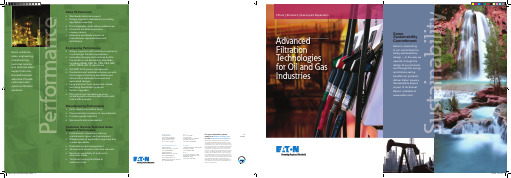
Advanced Filtration Technologies for Oil and Gas IndustriesFilters | Strainers | Gas Liquid SeparatorsP e r f o r m a n c eEaton combines sales, engineering, manufacturing, customer service, and technical sales support into one focused business objective: Provide customers with optimum filtration solutions.S u s t a i n a b i l i t ySales Performance• Worldwide technical support• Design engineers dedicated to providing application expertise• Knowledgeable inside sales professionals • Complete pre-sales application review process•Extensive worldwide network of manufacturer representatives and distributorsEngineering Performance• Design engineers with extensive experience in oil and gas filtration applications •Innovative designs and solutions built to the world’s more demanding standards, including ASME, PED, CE, CRN, CSA, NEC, ATEX, NACE, NR-13, and others • ISO 9001:2015 quality management •Customized and modular solutions provide a full range of retention capabilities and construction materials in manual and automated designs• Long and short-term equipment rentals, excluding ReactoGard products • System upgrades•Pilot plants and lab testing services,including particulate size distribution and total solids analysisManufacturing Performance• Fully capable fabrication shop• Comprehensive inventory of raw materials • Finished goods inventory •Spare parts and consumablesCustomer Service/T echnical Sales Support Performance• Field service—inspection, start-up, maintenance, repair, and replacement • Global access to application engineers and market specialists• Dedicated project management• 24-hour web access to technical manuals • Real-time availability of order entry and order status•Technical training facilitated at customer’s siteRReactoGard/ClearAmine Filter SystemGGas Liquid SeparatorA2596 - automatic self-cleaning strainerBFilter bags & bag filter housingsCCartridge filterSStandard& fabricated pipeline strainersStrainerClearAmine fi lter systemHeatexchangerSteamstripperStrainerFresh water tankWater inSteam inGas Liquid separatorTo claus reactorCartridgefi lter (carbon pre-fi lter)Carbon fi lterCartridge fi lterGas Liquid separatorGas Liquid separatorH 2SabsorberAmine fl ash tankTo watertreatmentNitrogen inTo fl areH 2gas outTo fl areNitrogen purgeSour gas inSSSCCStrainerContinuous in-line protection for your acid gas removal loopEaton can design solutions to meet your specifi c down-stream processes and fi ltration requirements in various hydrocarbon processing and support applications:• Gas Treatment Plant • Hydroprocessing Units• Water In-Take Cooling and Treatment • Liquifi ed Natural Gas • Oil Refi neries •PetrochemicalLean amine Rich amine Nitrogen WaterReactoGard CCartridge fi lterNext generation catalytic reactor protection for your hydroprocessing applications SStrainer SStrainerRSACASCBCTASB CWater in-take coolingand treatmentT echnical data reference to Eaton filters, separators and strainersEaton is capable of providing a complete solution to your refi nery process application; ranging from single fi lter housings to complete skidded systems with fi ltration, valves, instrumentation, controls, and interconnected piping.R。
高速过滤器使用说明书

高速过滤器使用说明书宜兴市知名环保有限公司目录一、总述二、技术规格及技术参数三、运行原理及滤料安装四、操作规程及注意事项一、总述高速过滤器在原水悬浮物较多的情况下能确保出水水质的高质量,具有过滤速度高、处理水量大、占地面积小等优点。
其操作为人工操作。
高速过滤器不仅适用于过滤处理悬浮物较多的原水,而且在循环供水系统中使用可改善水质,提高水的循环利用率,节约用水,是当前工业水处理设施中必备的设备。
高速过滤器的处理对象主要是机械杂质、胶体、微生物、有机物、油等。
其处理的好坏直接影响循环水工艺的技术经济效果和长期安全运行。
本过滤器其工作状态为压力式,滤料采用双层滤料,石英砂及无烟煤过滤,具有过滤截污能力大、过滤精度高,处理水量适中、占地面积小及除油等优点。
我公司早已把该产品用于钢铁厂中净化处理轧钢、连铸的浊水,净循环水系统中旁滤处理以及其它各种水质的过滤,经过多年运行考验,取得了十分满意的效果,深受厂矿企业用户的欢迎。
二、技术规格及技术参数(一)设备技术规格1、Φ3m高速过滤器:数量:2套单台处理水量:Q=≤280m3/h高速过滤器直径:3m(二)技术参数(1)Φ3m高速过滤器1)单台过滤面积;7m22)最高滤速:40m/h3)最大过滤水量:≤280 m3/h4)进水悬浮物≤80mg/L, 进水油含量≤20mg/L5)出水悬浮物≤10mg/L, 出水油含量≤5mg/L6) 过滤器内平均压力损失≤0.05MPa7)滤料高度:石英砂1200mm 无烟煤800mm 承托层高度:200mm8)进、出口公称直径:DN250 PN1.0反洗进、出口公称直径:DN250 PN1.0进气、排气口公称直径:DN80/DN100 PN1.0排水口公称直径:DN250 PN1.09)设备空重:~10.5t 设备运行重量:~80t三、运行原理及滤料安装该过滤器在运行时,过滤——投入反冲洗——终止反冲洗——恢复下一周期的过滤,均须采用阀门进行。
ZGLG全自动过滤器安装使用维护说明书
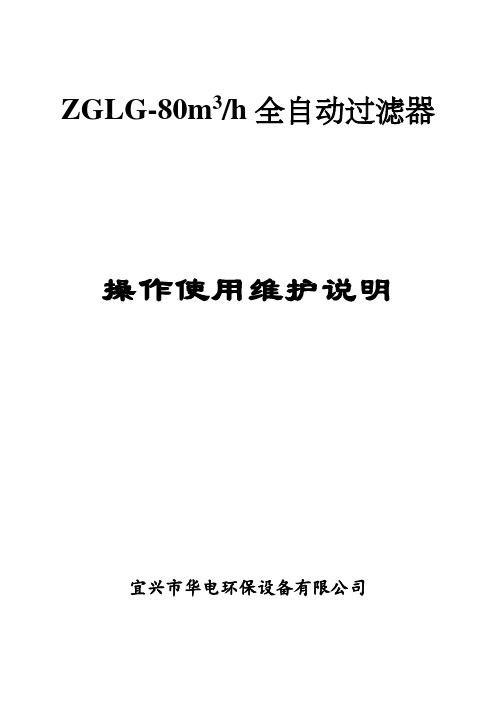
ZGLG-80m3/h全自动过滤器操作使用维护说明宜兴市华电环保设备有限公司ZGLG型全自动过滤器安装、操作维护手册一、产品介绍ZGLG全自动过滤器不同于目前国内生产的各种机械过滤器,不论是重力式、压力式、中速还是高速过滤器,都是人工控制反冲洗时间,同时需设置反冲洗水泵或高位水塔,但进入过滤器的原水浊度是不断变化着的,人为规定反冲洗时间,不是提前冲洗(造成浪费水源),便是“晚点”冲洗,造成滤料超负荷工作,使出水水质恶化。
ZGLG全自动过滤器可以克服上述过滤器工作过程中的缺点。
从进水、出水反冲洗及排污等全靠水力作用,实现全自动工作,无需专人操作管理。
由此,将彻底取代我国几十年来所生产的,适用于水处理的各类型过滤设备,具有较高的节水、节电、节人工、占地小、排污少等优点。
ZGLG型全自动过滤装置属非电控制过滤装置,全靠预过滤水的重力压力及机械原理实现全自动工作。
ZGLG型全自动过滤装置分为:重力式、压力式二种。
本次采用的为重力式,以下各设计参数均为重力式。
ZGLG型全自动过滤器技术性能表:二、适用范围ZGLG系列全自动过滤器装置,主要用以去除水中颗粒状杂质悬浮物,固体物及能形成吸附沉淀的过滤,提供符合各种不同用途的工业用水及生活用水。
是配套使用于大型工业循环冷却水的旁滤处理、地表水净化、地下水除铁除锰装置、生产废水去除悬浮杂质、二次沉淀处理之后的回用水后处理设备。
三、工作原理全自动过滤器采用小阻力排水系统,正向、重力式过滤以自身清水箱的水量,在虹吸原理的作用下进行反冲洗,因此无须象高速过滤器、中速过滤器、机械过滤器以及普通快速过滤器那样,必须设置反冲洗水泵或反洗水池,该过滤器一般分四只过滤室,所用的反冲管、清水管,分别布置在各自所在的滤室的轴心处,因此反冲洗配水均匀,滤后水采用滤帽集水,集水均匀,集水后汇集至清水箱出水。
全自动过滤器设备本体由滤罐、排水箱、配水箱、进水装置、虹吸上升管、虹吸下降管、虹吸破坏装置、虹吸辅助管等组成。
过滤器使用说明书

过滤器使用说明书第一部分: 引言过滤器是一种常用的设备,用于过滤,并去除液体或气体中的杂质、污染物和固体颗粒。
它们广泛应用于工业、化学、制药、食品加工等领域,以确保流体的纯净性和质量。
本文档将介绍过滤器的基本原理、使用方法和维护技巧,以帮助用户正确地使用和维护过滤器。
第二部分: 过滤器基本原理1. 过滤器类型过滤器可分为多种类型,常见的有压力过滤器、离心过滤器、溶剂过滤器和微滤器等。
每种过滤器均有其特定的过滤原理和适用范围。
2. 过滤器工作原理过滤器的基本工作原理是通过孔隙或网格的方式,将液体或气体中的固体颗粒或污染物截留在过滤介质上,从而实现过滤效果。
具体的过滤效率和排放质量将取决于过滤介质的材质和孔径大小。
第三部分: 过滤器使用方法1. 准备工作在使用过滤器之前,需要先进行准备工作。
包括检查过滤器的完整性,确认过滤介质的材质和孔径是否符合要求,以及清洗过滤器以去除可能存在的污垢和杂质。
2. 过滤器安装根据具体的过滤器类型和安装需求,选择合适的安装位置和固定方式。
确保过滤器与管道接口紧密连接,并采取必要的防漏措施。
3. 过滤器操作打开进出口阀门,并通过调节开关或控制面板等方式,调整过滤器的工作参数,如流速、压力和过滤介质的温度等。
监控过滤器的运行状态,并根据需要对过滤介质进行更换或清洗。
4. 过滤器维护定期检查过滤器的工作状态和过滤效果,如发现异常或降低的过滤效率,应及时采取相应的措施,如更换过滤介质或清洗过滤器。
同时,定期维护过滤器的操作记录,并保持过滤器周围的清洁和整洁。
第四部分: 过滤器常见故障排除1. 漏水问题如果发现过滤器存在漏水现象,首先应检查过滤器的密封性和连接部位,确保密封圈安装正确,并检查紧固螺栓是否松动。
如问题仍未解决,需要联系专业技术人员进行维修。
2. 过滤效果差如果经常发现过滤效果不佳,可能是过滤介质堵塞或饱和,需要及时更换或清洗过滤介质。
同时,检查过滤物的特性是否与过滤器的适用范围相符。
- 1、下载文档前请自行甄别文档内容的完整性,平台不提供额外的编辑、内容补充、找答案等附加服务。
- 2、"仅部分预览"的文档,不可在线预览部分如存在完整性等问题,可反馈申请退款(可完整预览的文档不适用该条件!)。
- 3、如文档侵犯您的权益,请联系客服反馈,我们会尽快为您处理(人工客服工作时间:9:00-18:30)。
GSL2.5高速过滤器技术说明
1、主要技术参数
数量:3台
单台处理能力:200m3/h
外形尺寸:φ2500
进出水管口:DN200
反冲洗管口:DN200
排污管口:DN100
人孔规格:DN500
排气孔:DN100配排气阀
管口法兰标准:JB/T81-94 PN=1.0MPa
适应水温:0—60℃
进水悬浮物:≤80-100mg/l
出水后悬浮物:≤20mg/l
最高滤速:40m/h
滤水面积:4.9 m2
最大滤水量:200m3/h
最大进水压力:不大于0.4 Mpa
反冲洗强度:40m3/m2.h
反洗水压力:0.15Mpa
过滤的平均压力损失:0.05Mpa
滤料:石英砂,总高度700mm
承托层:砾石,高度400mm
2、主要结构及工作原理
高速过滤器主要由筒体、封头、过滤系统、进出水系统、反冲洗系统等部件组成。
2.1主要结构
(1) 主体上下封头采用专业封头公司的正半椭圆形标准封头,筒体采用大厂钢板,坡口机打好坡口后,用卷板机卷制成形,筒体上的所有纵横焊缝均用埋弧
自动焊机焊接,其焊接质量符合GB150-1998钢制压力容器标准。
(2) 滤层出水装置采用厚质钢板装配专用滤帽(1t/h,ABS材质)组成,出水时均匀统一,并在下部设有工字钢作托架。
(3) 进出水系统及反冲洗布气进水系统的管件均采用无缝钢管,其管件均按S311钢制管道零件标准要求制造,所有法兰按JB81-94凸面板式平焊钢制管法兰标准制造。
(4) 反洗出水装置(进水分配槽)采用折板淹没式结构,可有效防止反冲洗时滤料的跑失。
(5) 过滤器整体制作完毕,每台进行压力试验,其试验方法和要求按GB150-1998钢制压力容器标准和JB2932-86水处理设备制造技术条件标准进行。
(6) 设备本体上设侧人孔,方便人员进出检修。
人孔材质为Q235A。
(7) 取样装置
在过滤器进出口水管正常流动的部位处设取样装置,可直接由管道引出;同时设取样阀和取样水槽等。
2.2工作原理
原水流入罐体内,由上而下经过滤料将原水中的油、悬浮物等予以截留,滤后水流出罐体。
当进出水压力差增大、滤速减漫、出水量降低时,反洗装置工作、反冲掉吸附于滤料上的杂物,保证过滤器的正常运行。
3、主要部件材质
主体:Q235碳钢
滤板:Q235碳钢
托架:Q235碳钢
进出水管:无缝钢管
反洗水、气管:无缝钢管
紧固件:Q235A碳钢
滤头:ABS
滤料:石英砂
4、设备设计、制造、检验所遵循的标准目录
该产品在设计、制造、检验、包装运输及安装过程中所遵循的标准均为国标
(GB)或部标(JB)这些通用标准目录省略,只提供专用标准目录如下:GB150-1998 钢制压力容器标准
JB/T2932-1999 水处理设备制造技术条件
JB/ZQ4000.2-86 切削加工件通用技术条件
JB/ZQ4000.3-86 焊接件通用技术条件
GB9787 热轧等边角钢
GB709 热轧钢板
Q/ZB75 机械加工通用技术条件
GB985 手工电弧、气焊及气体保护焊焊缝坡口的基本形式与尺寸ZBJ98004 水处理设备原材料入厂检验
GB6067 起重机械安全规程
ZBJ98003-87 水处理设备油漆、包装技术条件
GB50231 机械设备安装工程施工验收通用规范
GB50275 压缩机、风机、泵安装工程施工及验收规范
GB50268 给水排水管道工程施工及验收规范
JB/ZQ400.1-86 产品检验通用技术要求
JB/ZQ4000.10-86 涂装通用技术条件
JB/ZQ4286-86 包装技术通用技术条件
GB8923-85 防锈包装
YJ010 抛光喷砂技术条件及检验方法
5、设备的可靠性及耐久性
5.1设备无故障运行时间在20000小时以上。
5.2整机使用寿命在25年以上。
6、设备的防腐
采用喷砂除锈机除锈,除锈面达到100%,达到Sa2.5级规定;筒体外部涂
刷两层光辉防锈底漆,面漆涂刷两层树脂锤纹漆;筒体内壁及内部管道(外壁、内壁)除锈后,刷环氧富锌防锈底漆一道,再刷环氧沥青漆三道。
包装前对机加工面按GB4879标准要求做好防腐处理。
运输安装过程中涂层破损,严格按原涂装工艺进行修复,其质量水平不低于
原涂层的质量水平。
7、供货范围
7.1主机供货包括:壳体及封头、滤板、托架、人孔、进出水及反冲洗管口
7.2内部滤料(石英砂)
7.3进出水电动阀门、反冲洗电动阀门、排水阀、排气阀,每套过滤器7个
7.4现场电控箱(PLC控制,含差压控制器)
7.5随机备品备件(滤帽10件/台)
注:我单位供货至过滤本体管口上安装的阀门法兰出口止。
清水泵、气源、过滤器与其他设备的外部联接管道由用户自备。
